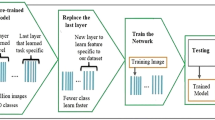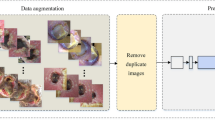Abstract
This research conducts an investigation on the effect of visually similar images within a publicly available diabetic foot ulcer dataset when training deep learning classification networks. The presence of binary-identical duplicate images in datasets used to train deep learning algorithms is a well known issue that can introduce unwanted bias which can degrade network performance. However, the effect of visually similar non-identical images is an under-researched topic, and has so far not been investigated in any diabetic foot ulcer studies. We use an open-source fuzzy algorithm to identify groups of increasingly similar images in the Diabetic Foot Ulcers Challenge 2021 (DFUC2021) training dataset. Based on each similarity threshold, we create new training sets that we use to train a range of deep learning multi-class classifiers. We then evaluate the performance of the best performing model on the DFUC2021 test set. Our findings show that the model trained on the training set with the 80% similarity threshold images removed achieved the best performance using the InceptionResNetV2 network. This model showed improvements in F1-score, precision, and recall of 0.023, 0.029, and 0.013, respectively. These results indicate that highly similar images can contribute towards the presence of performance degrading bias within the Diabetic Foot Ulcers Challenge 2021 dataset, and that the removal of images that are 80% similar from the training set can help to boost classification performance.
I. C. Dipto and B. Cassidy—Equal contribution.
Access this chapter
Tax calculation will be finalised at checkout
Purchases are for personal use only
Similar content being viewed by others
References
Yap, M.H., Cassidy, B., Pappachan, J.M., O’Shea, C., Gillespie, D., Reeves, N.D.: Analysis towards classification of infection and ischaemia of diabetic foot ulcers. In: 2021 IEEE EMBS International Conference on Biomedical and Health Informatics (BHI), pp. 1–4. IEEE (2021)
Cassidy, B., Kendrick, C., Brodzicki, A., Jaworek-Korjakowska, J., Yap, M.H.: Analysis of the ISIC image datasets: usage, benchmarks and recommendations. Med. Image Anal. 75, 102305 (2022)
Goyal, M., Reeves, N., Rajbhandari, S., Yap, M.H.: Robust methods for real-time diabetic foot ulcer detection and localization on mobile devices. IEEE J. Biomed. Health Inform. 23, 1730–1741 (2018)
Cassidy, B., et al.: The DFUC 2020 dataset: analysis towards diabetic foot ulcer detection. touchREVIEWS Endocrinol. 17, 5–11 (2021)
Yap, M.H., et al.: Deep learning in diabetic foot ulcers detection: a comprehensive evaluation. Comput. Biol. Med. 135, 104596 (2021)
Reeves, N.D., Cassidy, B., Abbott, C.A., Yap, M.H.: Novel technologies for detection and prevention of diabetic foot ulcers, chapter 7. In: Gefen, A. (ed.) The Science, Etiology and Mechanobiology of Diabetes and its Complications, pp. 107–122. Academic Press (2021)
Cassidy, B., et al.: A cloud-based deep learning framework for remote detection of diabetic foot ulcers. IEEE Pervasive Comput. (01), 1–9 (2022)
Pappachan, J.M., Cassidy, B., Fernandez, C.J., Chandrabalan, V., Yap, M.H.: The role of artificial intelligence technology in the care of diabetic foot ulcers: the past, the present, and the future. World J. Diab. 13, 1131–1139 (2022)
Goyal, M., Reeves, N.D., Rajbhandari, S., Ahmad, N., Wang, C., Yap, M.H.: Recognition of ischaemia and infection in diabetic foot ulcers: dataset and techniques. Comput. Biol. Med. 117, 103616 (2020)
Cassidy, B., et al.: Diabetic foot ulcer grand challenge 2021: evaluation and summary. In: Yap, M.H., Cassidy, B., Kendrick, C. (eds.) DFUC 2021. LNCS, vol. 13183, pp. 90–105. Springer, Cham (2022). https://doi.org/10.1007/978-3-030-94907-5_7
Yap, M.H., Kendrick, C., Reeves, N.D., Goyal, M., Pappachan, J.M., Cassidy, B.: Development of diabetic foot ulcer datasets: an overview. In: Yap, M.H., Cassidy, B., Kendrick, C. (eds.) DFUC 2021. LNCS, vol. 13183, pp. 1–18. Springer, Cham (2022). https://doi.org/10.1007/978-3-030-94907-5_1
Goyal, M., Yap, M.H., Reeves, N.D., Rajbhandari, S., Spragg, J.: Fully convolutional networks for diabetic foot ulcer segmentation. In: 2017 IEEE International Conference on Systems, Man, and Cybernetics (SMC), pp. 618–623. IEEE (2017)
Kendrick, C., et al.: Translating clinical delineation of diabetic foot ulcers into machine interpretable segmentation (2022)
Goyal, M., Reeves, N.D., Davison, A.K., Rajbhandari, S., Spragg, J., Yap, M.H.: DFUNet: convolutional neural networks for diabetic foot ulcer classification. IEEE Trans. Emerg. Top. Comput. Intell. 4(5), 728–739 (2018)
Al-Garaawi, N., Ebsim, R., Alharan, A.F.H., Yap, M.H.: Diabetic foot ulcer classification using mapped binary patterns and convolutional neural networks. Comput. Biol. Med. 140, 105055 (2022)
dupeGuru (2018). https://dupeguru.voltaicideas.net/. Accessed 7 June 2022
Acknowledgment
We gratefully acknowledge the support of NVIDIA Corporation who provided access to GPU resources for the DFUC2020 and DFUC2021 Challenges.
Author information
Authors and Affiliations
Corresponding author
Editor information
Editors and Affiliations
Rights and permissions
Copyright information
© 2023 The Author(s), under exclusive license to Springer Nature Switzerland AG
About this paper
Cite this paper
Dipto, I.C. et al. (2023). Quantifying the Effect of Image Similarity on Diabetic Foot Ulcer Classification. In: Yap, M.H., Kendrick, C., Cassidy, B. (eds) Diabetic Foot Ulcers Grand Challenge. DFUC 2022. Lecture Notes in Computer Science, vol 13797. Springer, Cham. https://doi.org/10.1007/978-3-031-26354-5_1
Download citation
DOI: https://doi.org/10.1007/978-3-031-26354-5_1
Published:
Publisher Name: Springer, Cham
Print ISBN: 978-3-031-26353-8
Online ISBN: 978-3-031-26354-5
eBook Packages: Computer ScienceComputer Science (R0)





